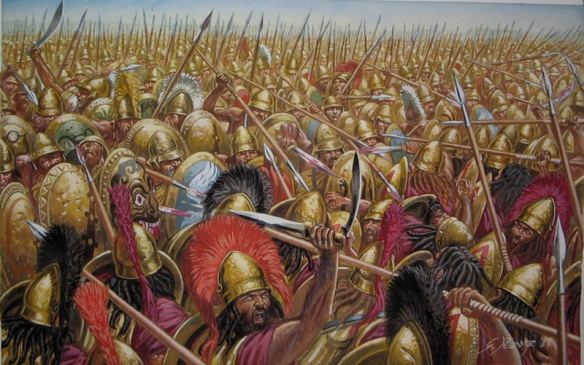Date July 371 BCE
Location Central Greece
Opponents Thebes and Boeotian League versus Sparta and Peloponnesian League
Approx. # Troops
Thebes and Boeotian League: Epaminondas 6,000 hoplites and 1,500 cavalry
Sparta and Peloponnesian League: Cleombrotus 10,000 hoplites and 1,000 cavalry
Importance Marks the end of Spartan military invincibility and the beginning of Theban hegemony; also leads to changes in military tactics
The Battle of Leuctra, between Thebes and Sparta, was one of many in the wars for Greek hegemony. Following its victory over Athens in 404 BCE in the Peloponnesian Wars, Sparta became the dominant power in Greece but used its position to pursue an expansionary policy. In 383 in an act of blatant aggression, Sparta seized Thebes. Theban exiles liberated their city in 379, but Sparta’s action had made a staunch enemy of Thebes, which was at first assisted by Athens. Thebes and Athens now worked together to expel Spartan forces from central Greece and also defeated the Spartans at sea off Naxos in the Aegean in 376.
Thebes reclaimed its position of leadership in Boeotia, bullying some city-states and destroying others in order to revive the Boeotian League under its leadership. Athens viewed this with alarm, however, and in these circumstances Sparta proposed a peace conference in 371. The talks deadlocked, and the Theban representatives, led by Epaminondas, walked out. Not wishing to give Thebes time to gather forces, King Cleombrotus of Sparta opted for a quick invasion.
The two sides met at Leuctra in Boeotia, some eight miles southwest of Thebes, sometime in July 371. Cleombrotus commanded some 10,000 Spartan and Peloponnesian League hoplites and 1,000 cavalry, while Epaminondas commanded the Boeotian League’s 6,000 hoplites and 1,500 cavalry. The Spartans used their cavalry basically as a reconnaissance force, while the Thebans employed theirs in combat. Given Cleombrotus’s nearly twofold advantage in manpower, all of Greece expected a Spartan victory.
Epaminondas had the advantage of being able to choose the battlefield, and he established a fortified camp to block the Spartan approach to Thebes. As he would undoubtedly lose to the Spartans in the shoving contest that typified phalanx warfare, he developed tactics that, while they had been seen before, were new in their degree. Epaminondas expected that the Spartans would place their best troops on the right flank. He therefore deliberately weakened his right flank and strengthened the left flank to meet the Spartans in oblique attack formation, with a left flank 48 ranks deep instead of the customary 8-12 ranks deep. The 300-man Theban Sacred Band, formed of 150 homosexual couples as the elite force of the army, held the Boeotian League’s extreme left flank. The plan was both bold and innovative.
The oblique order allowed Epaminondas to refuse (i. e., hold back from the direct line of battle) his right flank, which was to act, with cavalry, as a holding force against the numerically superior Spartan left flank. Epaminondas hoped that he could win the battle with his powerful left flank before his weakened right flank could lose it.
Both sides were drawn up in linear formation, separated by about a mile of open plain. The Spartan cavalry was in front of its army’s right flank, while the Theban cavalry was split between the flanks. Epaminondas attacked, first sending in his cavalry, which easily drove the Spartan horsemen from the field. The Theban hoplites then advanced, the powerful Theban left flank crashing into the Spartan right flank. Despite heavy resistance, the Spartans could not withstand the overwhelming Theban pressure. The Spartan left flank took no part in the battle, as the refused Theban right-flank infantry and cavalry were too far away.
Epaminondas’s forces moved to the right and advanced on the remaining Spartan line. The Spartan ranks broke and the men fled, leaving the Thebans in possession of the field and victory. Theban casualties in the battle were light, while the Spartans lost perhaps 2,000 men. After the battle, both sides were open to negotiations. Spartan forces were permitted to withdraw back into the Peloponnese.
This battle amazed all of Greece. Not only did it lead to changes in tactics, but it marked the end of Spartan military invincibility and the beginning of a period of Theban hegemony. Thebes raised up Messenia as an independent state after centuries of helotism, an action that deprived Sparta of the economic means to maintain the traditional state structure on which its military supremacy had rested. Sparta sank to second-class status. Thebes, however, proved incapable of leadership, and Athens combined with Sparta against Thebes. The continuation of inter-Greek warfare made the Greek city-states susceptible to outside invasion, and in 338 Philip II of Macedon won the Battle of Chaeronea, ending the warfare that had plagued Greece for centuries but also bringing to a close Greek independence.
References Buckley, John. The Theban Hegemony. Cambridge: Harvard University Press, 1980. Delbruck, Hans. Warfare in Antiquity. Translated by Walter J. Renfore Jr. Lincoln: University of Nebraska Press, 1990. Warry, John. Warfare in the Classical World. New York: Salamander Books, 1993.
